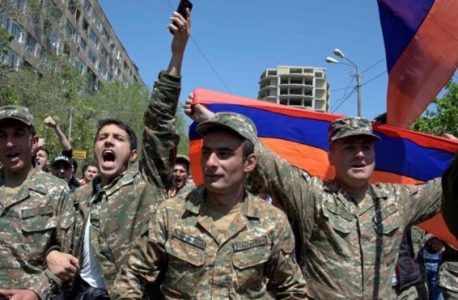By Natalie Glezou for Greek City Times
The Azeri invasion of Artsakh that began on September 27 exemplifies a demonstration of their decades-long policy of hatred against Armenians.
“Is it a defeat or a victory? The target of the Turko-Azeris was never only the territories. They have always been the Armenian people. It was the destruction of a people, which, however, like the Phoenix, is reborn through its ashes. Now what is she? Defeat or victory?” Maria Lazareva wondered, as previously published on Greek City Times.
The Russian-mediated ceasefire agreement between Armenia and Azerbaijan includes the surrender of the territories to the Azerbaijani military that they never even captured, and the territories they already captured with assistance from Syrian jihadist mercenaries and Turkish military forces during the conflict.
This makes up 15-20% of the total territory of Azerbaijan, as well as the historic city of great religious and strategic importance, Shushi.
Specifically, three regions of Artsakh will be put under the Azeri state-control by December 1: the regions of Aghdam, Kalbajar and Lachin.
Specifically for the latter region, the Lachin Corridor, the mountain pass connecting Artsakh (Nagorno-Karabakh is a combination of Russian, Farsi and Turkish to mean “black mountain garden”) with mainland Armenia, is being monitored by Russian peacekeepers.
Also, the territory under Armenian control since the 1990s, outside the territory of Artsakh, will be handed over to the Azeris.
In a speech, Azerbaijani President Ilham Aliyev stressed:
“The enemy who has been illegally occupying our territories for 30 years sees the strength of the Azerbaijani army on the battlefield. We are fighting in our lands, we are defending our land and we will continue to drive the ‘invaders’ from our land.”
For the city of Sushi, the Azeri president wrote on Twitter:
DEAR SHUSHA, YOU ARE FREE! Dear Shusha, we have returned! Dear Shusha, we will reinvigorate you! Karabakh is ours! Karabakh is Azerbaijan!
— Ilham Aliyev (@presidentaz) November 8, 2020
During the conflict, the inhumane torture and atrocities against Armenian prisoners that took place during the period from November 4-18 alone are recorded by the mediators of Armenia and Artsakh, Arman Tatoyan and Artak Beglaryan.
Through these documents, which will be sent to state authorities and international organizations to reflect on the irrefutable evidence of war crimes by the Azeris against war prisoners, showing the painful consequences of the Azerbaijani policy of hatred and ethnic cleansing against Armenians.
And we are not just talking about the loss of land and human lives, where according to estimates, for the Armenian side, amounts to at least 2000 dead, while there are many missing.
We are referring to the cultural “genocide”, the desecration and destruction of cultural and religious monuments by the Azerbaijani army and its allies, in order to eliminate any trace of the undeniable presence, existence and property titles of the Armenian people in their homeland.
They want to rewrite the story….

In the Nakhichevan region alone, according to satellite images and other incontrovertible evidence from archaeologists and researchers, 89 churches, 5,840 khachkars and 22,000 tombstones were desecrated and destroyed between 1997 and 2006, as was the largest ancient Armenian cemetery, Djulfa.
President of the Union of Greek Communities, Maria Lazareva, on media panels commented on the military defeat in Artsakh and said the following Armenian proverb: “The victory has a thousand bosses but defeat is an orphan.”
The first priority for the Armenian people of Artsakh and for their homeland is the de jure recognition, first by Armenia itself, Russia and then the entire international community.
Karvachar yesterday, Armenians left welcome signs for Azerbaijanis.
The one in Russian reads: “Azerbaijanis, (take note), we will come back.” pic.twitter.com/QO47hlR0Ge
— ASB News / MILITARY〽️ (@ASBMilitary) November 22, 2020
“Victory or defeat” says Lazareva…
The response from the proud heroic people of Karvachar who, temporarily, leave their ancestral homes, writing in Russian “welcome” messages to the new owners of their property and land:
“Azeris, remember, we will be back.”

